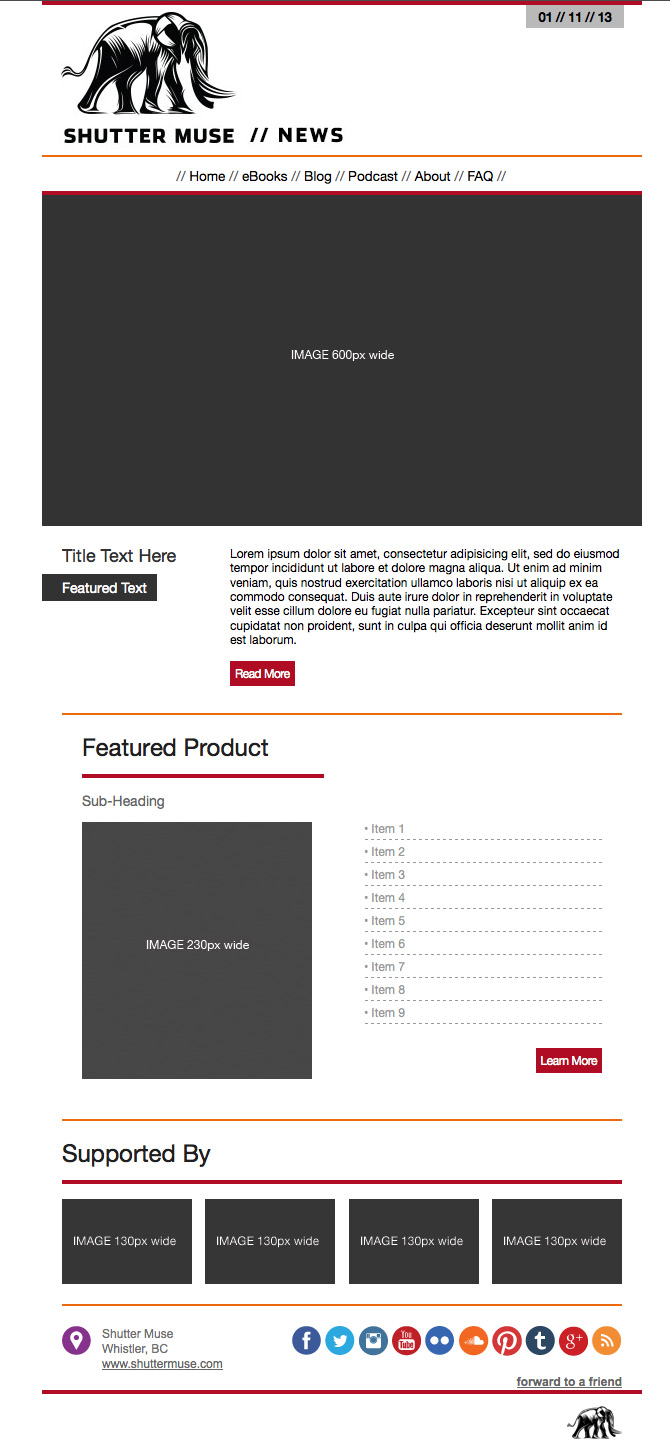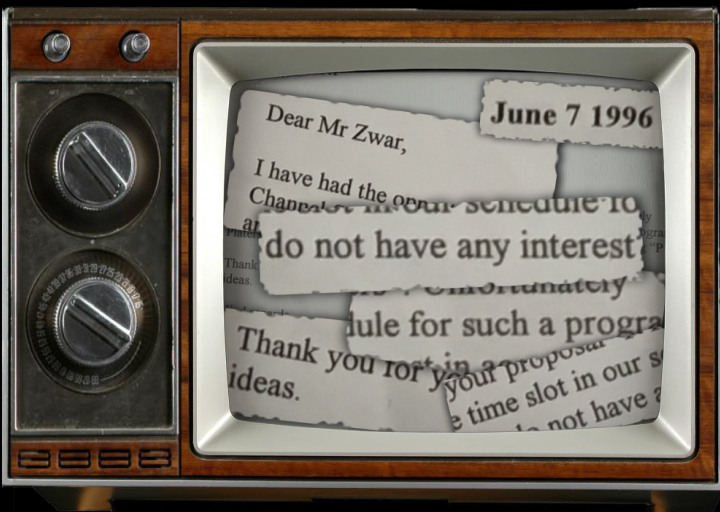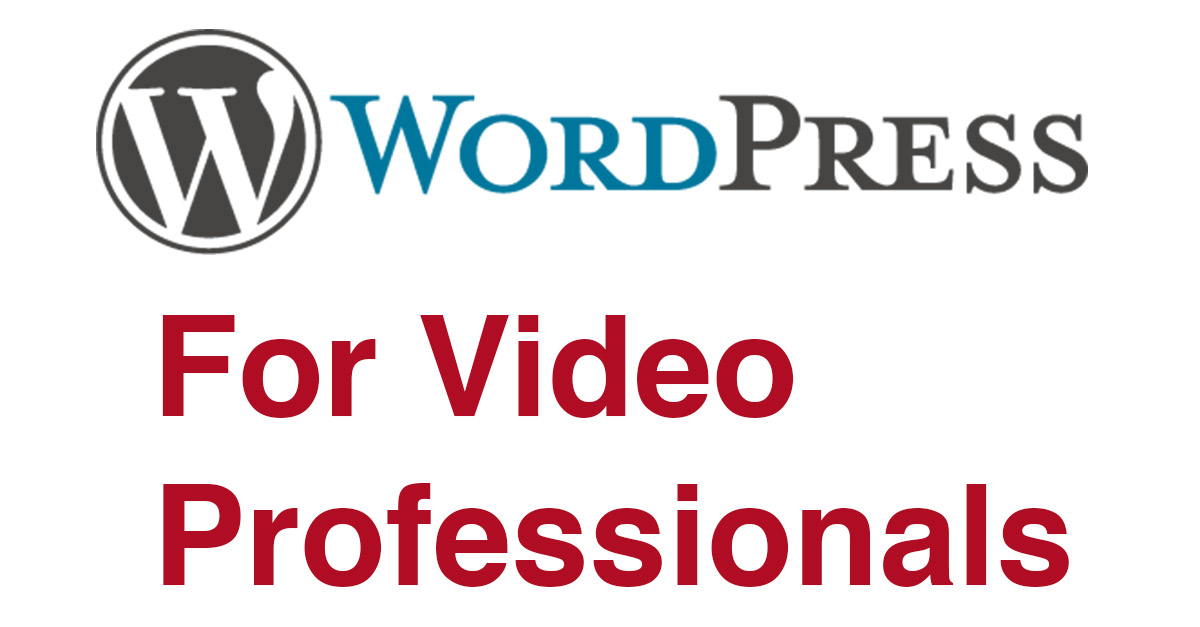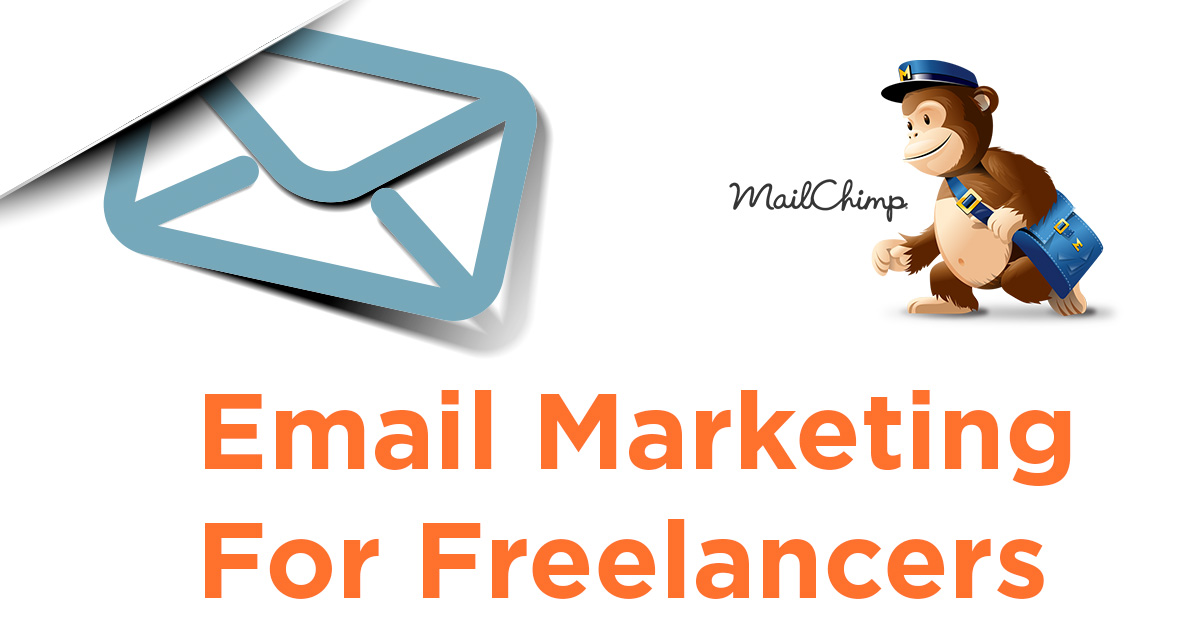
I started off this series of posts last month with a look at simplified accounting for freelancers, using FreshBooks. This month I want to talk about an incredibly powerful, yet highly underused marketing tool, the email newsletter.
Not setting up an email list when I first started my business is the absolute number 1 mistake that I made when I look back on things. It took me years and years before I finally took notice of all the advice out there that points to how effective it can be. It’s not that I didn’t know about it, but that I had assumed it was a time consuming endeavor to get started with. Once I finally got around to it I was amazed how simple it was to implement, and even more amazed to find that I could do it for free.
So why is email marketing so important? There’s really two main points to my answer and the first is that your e-mail list is yours, forever. What I mean by this is that all other forms of connection to fans and potential clients are generally handled by one or other form of social media. The problem with this is that any of these social platforms that we invest so much effort into growing, could tank at any moment. As unlikely as it may seem, you only have to remember MySpace and what happened there. Now I’m not saying this is going to happen overnight, but can you honestly say that in 10 years time we’ll still be using Twitter? If or when these social networks disappear, all of your connections will be lost. When growing an e-mail list though you can rest safe in the knowledge that the information is yours and nobody is ever going to take it away from you.
Many freelancers use Facebook to share their latest work and connect with fans and new clients. Whilst Facebook will clearly be around for at least the next few years, many business were hit hard by their sudden changes at the end of 2013 which saw the organic reach of content slashed drastically. Where posts and shared videos used to reach upwards of 50% of the people who “liked” a page, suddenly it was down to single digit percentages. I know several people who had spent a lot of money on Facebook ads to build their following, only to find that now they were being forced to pay again to “promote” their posts and get their content in-front of those people. We have zero control over these kinds of social networks so it’s a dangerous game to rely on them as our digital promotional channel.
The second major reason for list building is that email is a much more personal way to contact someone and it’s far more professional than any form of social media. Worldwide e-mail traffic still outguns social posting by a huge margin and you have a much more captive audience when an e-mail lands in someone’s in-box. Facebook and Twitter are like fire hoses these days with the average person following hundreds of people and brands. You simply can’t rely on everyone seeing your Tweets and Facebook posts since most people don’t tend to scroll past the end of the first page. With email marketing though, you are building direct access to someone’s in-box; a guaranteed connection. Not only that, but you also have the ability to showcase your work in ways that’s simply not possible via social networks, whilst also maintaining total control over your branding. Sharing your latest projects on a monthly, bi-monthly or quarterly basis will help to ensure that it’s your name on the tip of a client’s tongue when they are planning their next project.
Whilst it’s not possible to embed videos directly into an email newsletter, a few good frames from the project and a link to your website to view the work will do just fine. Do not use a link directly to YouTube or Vimeo though! The aim is to reinforce your brand and your work in the client’s mind. Make sure you send them to your site where they have easy access to your contact form and previous work without being distracted by all the other things you find on public video hosting sites. By all means upload the video to those sites, but then embed them on your site and send people there to watch them!
Getting started
The worry of an additional monthly subscription cost was another factor that initially prevented me from starting a mailing list. When I discovered that you can start for free, and potentially stay free forever I was stunned!
To send e-mail campaigns and build your list you’re going to need an ESP or E-Mail Service Provider. This is a service that allows you to create a sign-up form for people to be added to your lists. You can manage the lists, design campaigns and then send them out to all your subscribers (or just segments of your list if you prefer). Once the e-mail campaign has been sent, the ESP will provide you with important stats such as open rate and click-through rate, showing you which was the most engaging part of your newsletter. There are a great many ESPs out there but here are a few of the most popular:
All ESPs have different pricing models; some base their prices on the number of subscribers you have and some charge on a per campaign basis like $0.01 per e-mail. I evaluated these services and chose Mailchimp to run the lists for my various businesses. What I loved about Mailchimp was how quickly I felt at home with their tools. I had multiple lists for multiple businesses created in just a few minutes and even though it took me a while to build it up to the point where I sent my first newsletter, getting over that initial hurdle was simple. What’s more, Mailchimp has what they call the forever free plan which lets you use it for free for up to 2000 subscribers. There’s no expiry date and no credit card needed. As long as you don’t grow to more than 2000 subscribers there’s no need to pay a single cent! The worry of an additional monthly subscription cost was another factor that initially prevented me from starting a mailing list. When I discovered that you can start for free, and potentially stay free forever I was stunned! Depending on how you use it, 2000 subscribers could be more than enough for creative freelancers and to keep in touch with past clients and possible leads. If you have a large following of fans that might want to sign up then at some point you’ll probably break into the paid plans, but if you are solely using it to connect with agencies and past clients then I doubt many will reach the 2000 person barrier.
How and where to collect your e-mails

Once you have a list set up you need to start getting those contacts on it. Whilst it is possible to buy email lists of creative directors and agencies, I would personally stay away from that kind of thing as I think it’s a very spammy approach (and not legal in some countries). Mailchimp, or any other ESP, will give you several easy ways to include sign up forms on your website, such as a simple embed code or a widget for your WordPress blog. Personally I have had great success with including the newsletter signup within my contact form on my portfolio website. When someone sends me an e-mail they fill out the form on my website and I have a small check box at the bottom that asks whether they would also like to receive the monthly newsletter. I get a much better conversion rate from this than anything else I have tried and I use the WordPress plugin Gravity Forms to craft this contact form with built in Mailchimp integration.
Other great places to sign people up:
- A link to the form in your email signature
- A signup form at the bottom of every blog post
- A link to the form in your ‘Contact’ menu on your website
- A signup app on your Facebook page (easy to do and free)
- Occasional Tweets or Facebook posts drawing people’s attention to your newsletter
- A link on your LinkedIn page
- A courteous enquiry to a client you’ve just finished business with; “would you mind if I added you to my mailing list? I’d love to be able to share my projects with you.”
If you use a WordPress website then I can highly recommend the plugin called OptinMonster. It gives you a plethora of ways to get signup forms onto your site in eye-catching designs and I use it on all of my sites.
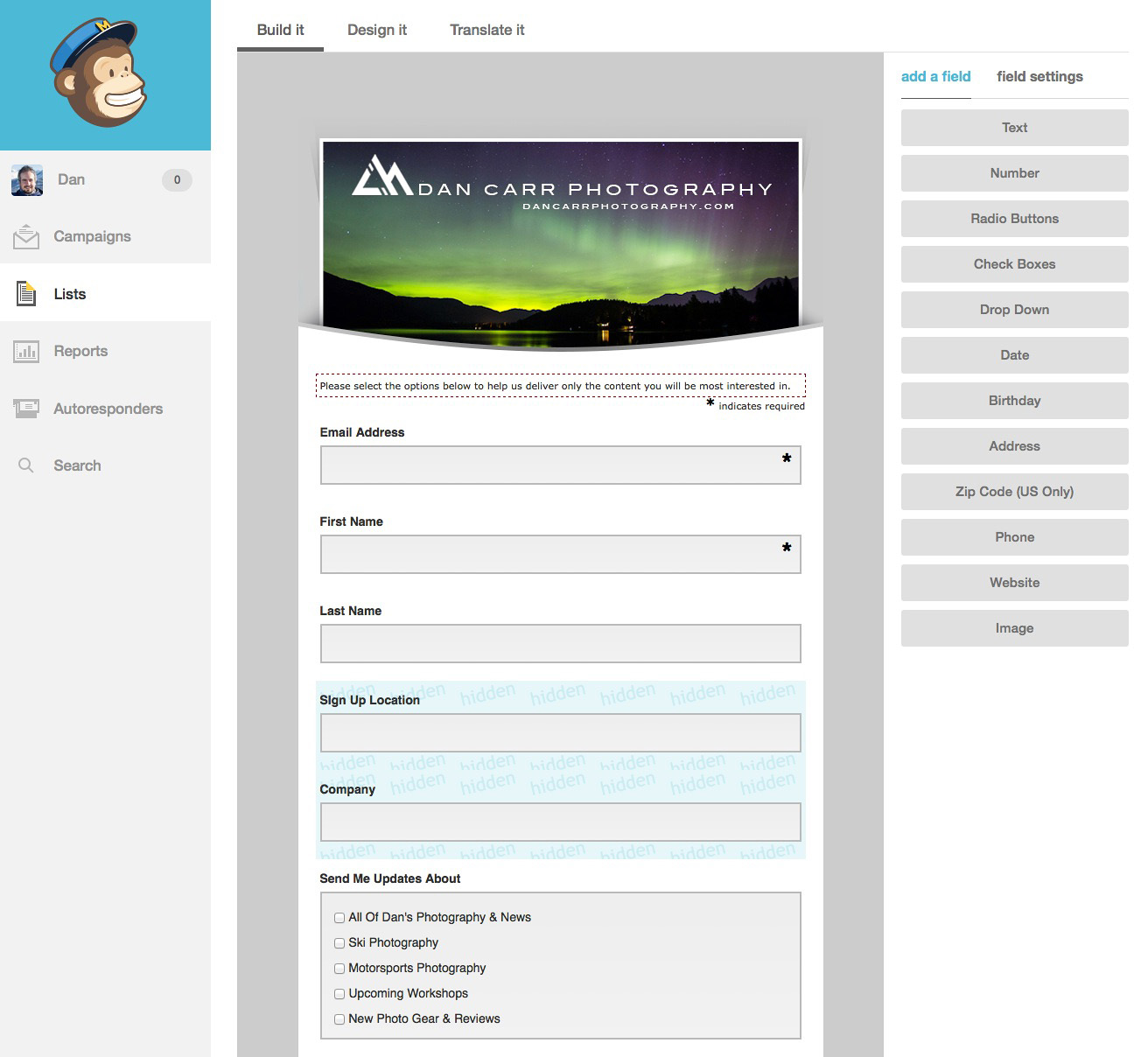
Segmenting your lists into different categories is a great way to maintain a high open rate with your subscribers. When you have a single list, you don’t have to send a newsletter to everyone on that list, complex rules can be set up to target smaller segments. For example, on my ski photography website anyone that signs up there goes into a specific ski photography segment of my list. Those people will only receive a newsletter if it contains content about skiing. If that’s what they are interested in, there’s no point sending them other updates as you’re more likely to have them looking for the unsubscribe button. If the newsletter contains some content about ski photography, but also has other subjects as well, I craft a quick variation of the newsletter that includes a skiing image right at the top to catch their attention. Essentially changing the order of the content in the newsletter to target peoples interests. The first image in your newsletter dramatically affects open rate so make sure it’s bold, and target it to your segmented lists. You can have people people automatically assigned to specific lists using a simple check box in your subscribe form that asks them what they are interested in. All ESPs will have ways to achieve this but once again I was impressed with the simplicity of Mailchimp’s method.
The Lead Magnet Approach
There’s not doubt that just having a simple sign-up box on your site will lead to only a small number of subscribers and this may or may not suit your purposes. This method will ensure your list only contains people that are truly interested in keeping tabs on your latest projects, but what if you want to grow your reach and following? There’s a good number of reasons these days why building a solid group of followers can be beneficial to your business. Perhaps that’s a post for another day, but if you are interested in building a large list then using a lead magnet is the most efficient way to do it. A lead magnet is essentially a bribe, “sign up to my newsletter and you’ll get XYZ for free”. The type of magnet you choose will have an influence on the type of subscribers you attract so you’ll want to have a good idea about how you plan to use your mailing list. For example, you could create a short eBook that demonstrates a particular technique. I’ve used this method myself to add many thousands of people to my mailing lists, but with this your list is not likely to be filled with potential new clients. If you purely plan to target new clients with your newsletter than you might consider something like an extended “behind the scenes” look at one of your latest projects. Choose a new project and docuement every step of it from planning to delivery and then package that up into a short digital magazine. This will give potential new clients a look at your skills and your methods. Creating a digital magazine is easy these days using Apple’s free iBooks Author app and I was able to create a lead magnet in just a few hours with it that’s so far added over two thousand people to one of my own lists. When people confirm their subscription to your mailing list they will be sent a confirmation email. Simply include the download link to your magnet in that email!
If you do take this approach, take the time to make your lead magnet look appealing. The website PSDCovers has a ton of free Photoshop scripts that can help turn your magazine or eBook covers into professional and desirable downloads in just a few seconds. Below is an example that I created for my latest eBook using one of these free scripts.
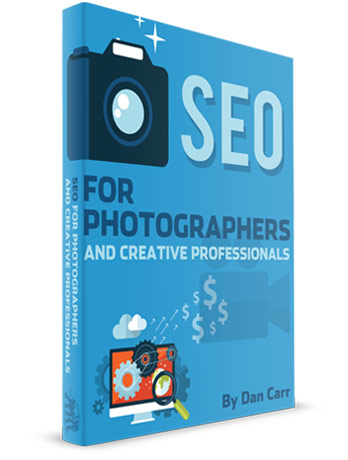
Designing your newsletter

Newsletters can typically be designed and sent in two different ways; with tools provided by the ESP, or with custom designed HTML templates built by a web designer.
Almost everyone will be able to craft a beautiful and simple newsletter using the Mailchimp tools and there are several ways to go about it:
Drag & Drop Editor
As the name suggests, this tool allows you to move text and image blocks around to create your perfect design. You have total control over the branding and layout and as creatives this is great so that we can craft a layout that really shows off our latest work.
Basic Templates
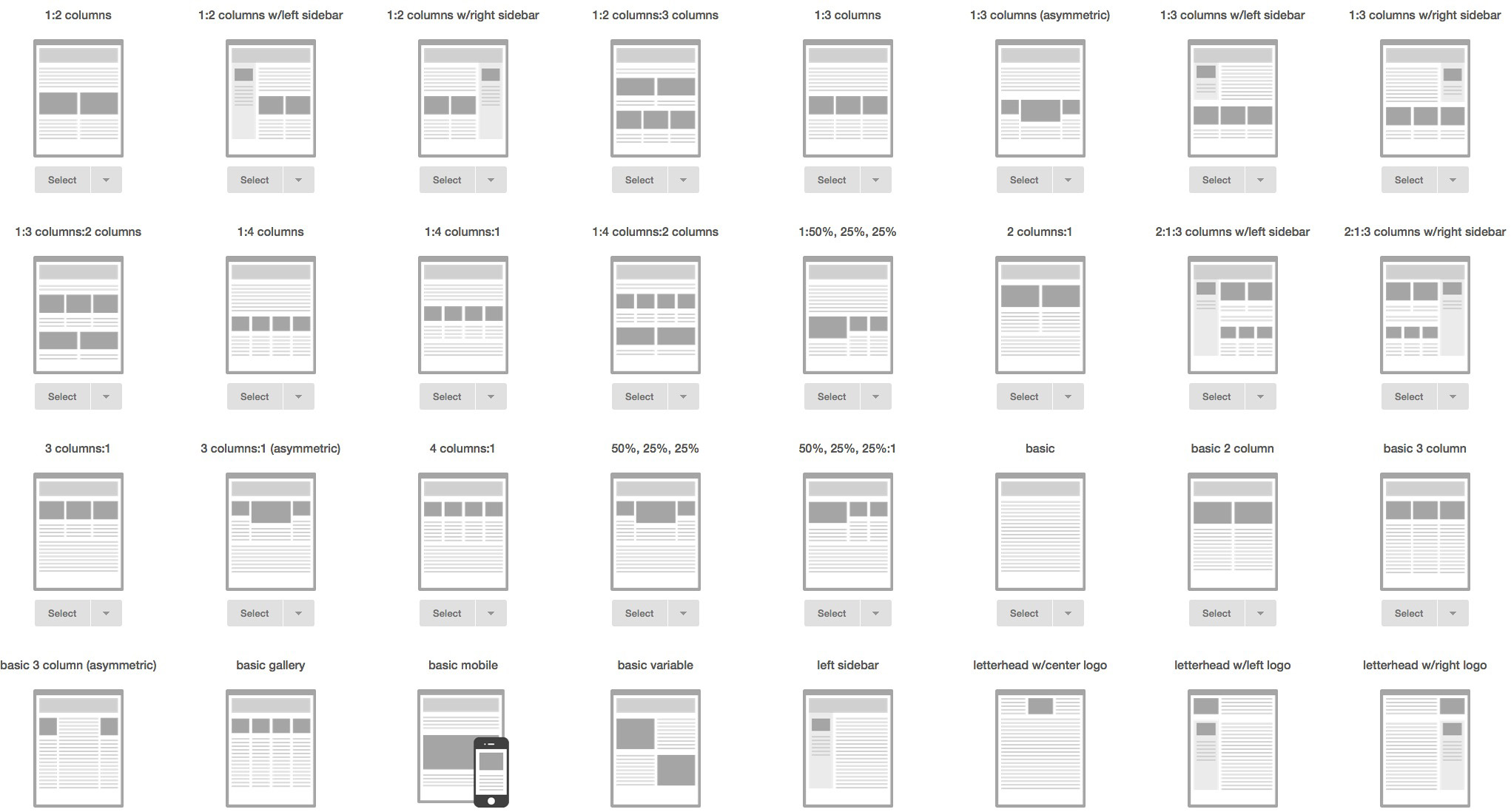
If you don’t want to delve immediately into totally custom designs you can pick from a range of great templates that can be used as starting points. All you need to do is drop your content into the boxes and away you go. You’ll still maintain total control over the branding and colors so you can tweak it to match your style. Mailchimp has roughly 50 basic templates that act as great starting points for a variety of different e-mails. Whether it’s sending just one large image from your latest project with an invitation to click through and view a new gallery; or whether it’s a full magazine style account of what your business has been up to for the last month, there’s a template to suit.
Predesigned Templates
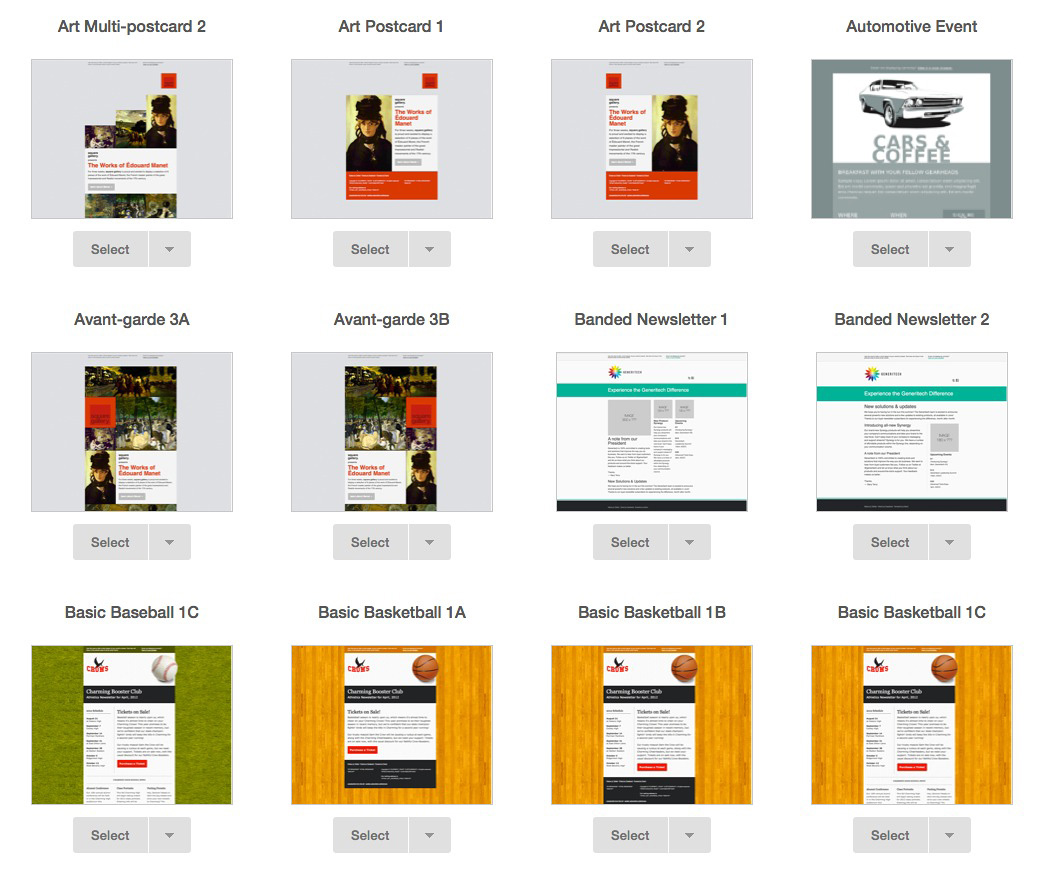
There’s also a couple of hundred templates that are instantly available for more specific purposes and occasions. Everything from art gallery invitations to product announcements and seasonally themed designs like Halloween and Christmas.
Totally Custom HTML Designs
E-mail newsletters are essentially just web pages that you e-mail to someone’s in-box, so they can be designed just like a web page as well. If you want to craft a very specific design, perhaps to make it identical to your portfolio website, then you can have a web designer create almost anything you can imagine. The code that they create is then uploaded into Mailchimp and sent just as any other campaign would be. This is a more advanced and certainly not necessary for most people though it is how I chose to do mine for a while before MailChimp launched their drag & drop editor. You should be able to have a good designer create a custom design with multiple variations for $300-$500.
Analyzing your sent campaigns
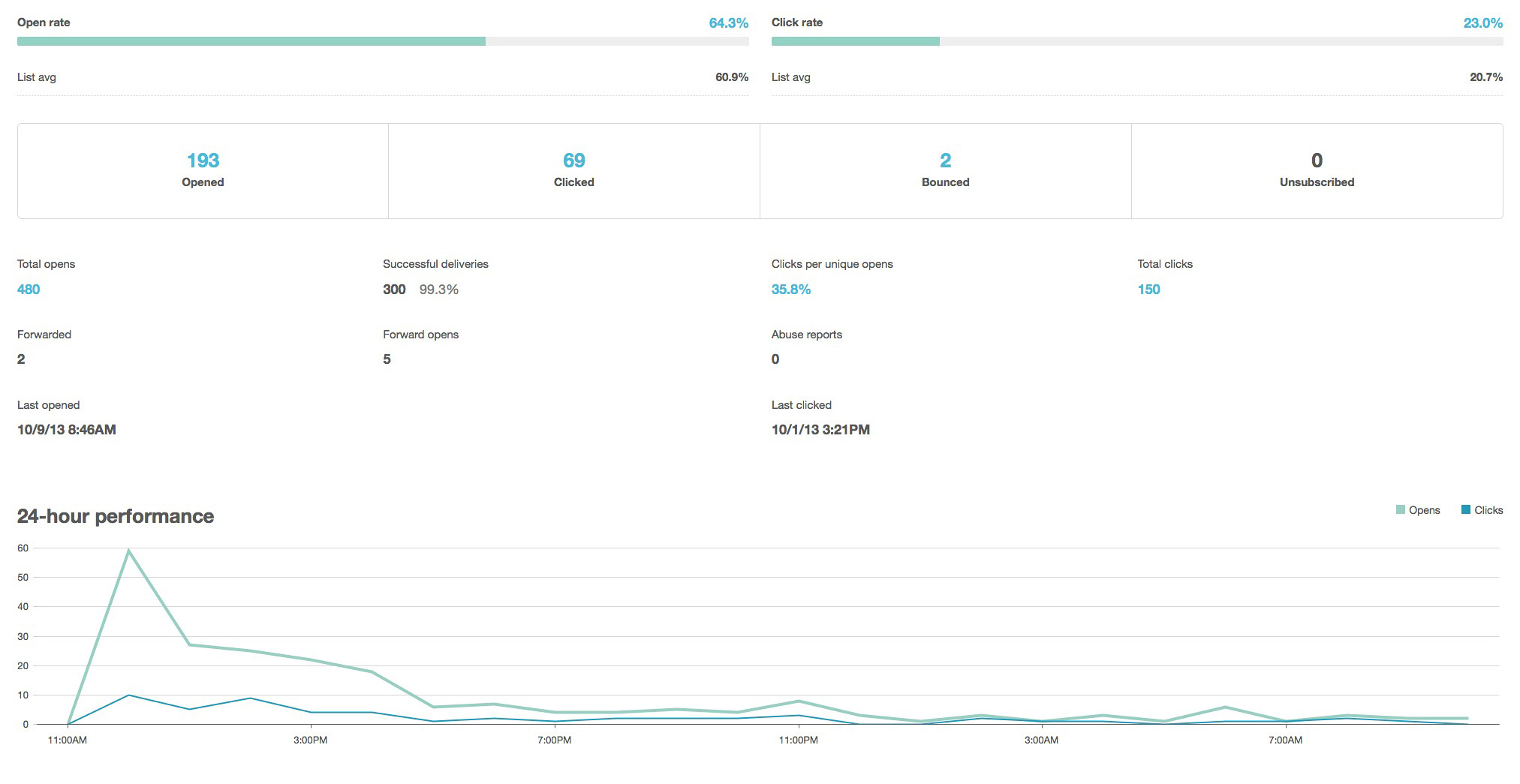
Once you’ve designed and sent your first campaign Mailchimp will give you access to some nice stats telling you, among other things, how many people opened it and which links most people clicked on. It will also show you the open rate Vs. time plot which gives great information about when most people saw the e-mail. A/B split testing also allows you to send two variations of the same newsletter and then compare the different results side by side. This kind of multivariate testing is a great way to iterate your way to the perfect newsletter design for your audience. Just a simple change to the subject line of the e-mail, or the tone of the opening image, can have a big impact on the open rate and resulting engagement of your e-mail. Mailchimp makes A/B testing so easy that you can always test out small tweaks every time you send a campaign. Since you can track who opens your e-mails, you can even target those who didn’t open your last e-mail with a slightly different version to try and get them to take a look at the next one. Perhaps a 20% off coupon for your print store or free downloadable PDF of images from your latest photo expedition.
Autoresponders
Autoresponders (recently re-named in Mailchimp to Automation) are pre-crafted newsletters that are sent automatically when a certain criteria is met by one of your subscribers. Example criteria could be:
- Subscriber joined your list within the last 24 hours
- Subscriber clicked a specific link within one of your newsletters
- Subscriber has not opened any of your last three newsletters
……..the list of possibilities is almost endless.
So how can you use these autoresponders to your advantage? One of my favorite ways is to send people a welcome that introduces them to the type of work that you do. When people fulfil certain criteria on my list, I send them a welcome e-mail that contains a quick paragraph about me and my work, and then links to specific portfolios. A previous client might know that you are a killer 3d artist, but maybe isn’t aware that they could hire you as an editor as well.
Getting deeper into email marketing
If this is the first time you have considered starting a mailing list I would urge you not to make the same mistake that I did. Don’t waste any time, set aside 15 minutes in the next 7 days and sign up for a free account with Mailchimp to get started right away. You don’t need to make any commitment to sending your first campaign, but at least start gathering people on your list. If you aren’t ready for a monthly newsletter, start out with a quarterly one and grow from there.
Be aware of your local spam laws
Every country has slightly different laws when it comes to spam emails. It pays to know what those are and all companies like Mailchimp will have some resources to help with a little research. In my home country of Canada for example, they passed what many people claim to be the toughest spam laws in the world in summer 2014 which forces many people to re-think their list building strategies or face massive fines. In general, as long as you are clearly asking people for their permission to be added to your list, you’ll be fine, but do make sure to do a little reading on the subject before you start.

Filmtools
Filmmakers go-to destination for pre-production, production & post production equipment!
Shop Now
